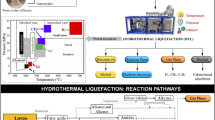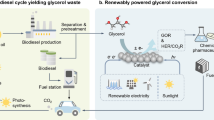Abstract
Escalating demand for biodiesel production has generated surplus glycerol. Therefore, the consumption of glycerol for valuable conversions has become a global challenge. In an effort to convert glycerol, we have etherified it to make a biologically active component, 3-(1-phenylethoxy) propane-1,2-diol. Etherification of glycerol with 1-phenyl ethanol was carried out by using heterogeneous acid catalysts. The process is green and clean. Different types of heteropolyacids (HPAs) supported on hexagonal mesoporous silica (HMS) and K-10 clay were prepared by incipient-wetness technique and screened to get high selectivity towards monoether of glycerol. 20% w/w dodeca-tungstophosphoric acid (DTP)/HMS was found to be the best. The effects of various reaction parameters such as speed of agitation, catalyst loading, mole ratio of reactants and temperature were evaluated systematically to prove that the reaction obeys Langmuir–Hinshelwood–Hougen–Watson (LHHW) type of mechanism. It was also observed that the reaction was free from any external mass transfer as well as intra-particle diffusion limitations and was intrinsically kinetically controlled. An overall second order kinetic equation was used to fit the experimental data, under the assumption that all the species are weakly adsorbed on the catalytic sites. Apparent activation energy was estimated as 27.0 kcal/mol. Solvent-free condition for this reaction has also added the green chemistry perception to the reaction.









Similar content being viewed by others
Abbreviations
- a p :
-
Solid–liquid interfacial area (cm2/cm3 of liquid phase)
- A:
-
Reactant species A—1-phenyl ethanol
- AS:
-
Chemisorbed A
- B:
-
Reactant species B—Glycerol
- BS:
-
Chemisorbed B
- P:
-
Monoether of glyceryl ether (product)
- PS:
-
Chemisorbed Product
- W:
-
Water
- C A, C B :
-
Concentration of A and B (mol/cm3)
- C A0, C B0 :
-
Initial concentration of A and B (mol/cm3)
- C AS, C BS :
-
Concentration of A and B at solid (catalyst) surface (mol/g cat)
- C PS, C WS :
-
Concentration of P and W at solid (catalyst) surface (mol/g cat)
- C S :
-
Concentration of vacant sites (mol/g cat)
- C t :
-
Total concentration of the sites (mol/g cat)
- C WP :
-
Weisz–Prater constant
- D P :
-
Diameter of catalyst particle (m)
- D AB :
-
Diffusion coefficient of A in B (m2/s)
- D BA :
-
Diffusion coefficient of B in A (m2/s)
- D e :
-
Effective diffusivity (cm2/s)
- Rp:
-
Radius of catalyst particle (m)
- −r A :
-
Rate of disappearance of A (cm3/gmol s)
- k SLA, k SLB :
-
Solid–liquid mass transfer coefficients (m/s)
- K A :
-
Equilibrium constant for adsorption of A on catalyst surface (l mol−1 min−1)
- K B :
-
Equilibrium constant for adsorption of B on catalyst surface (l mol−1 min−1)
- k SR :
-
Surface reaction rate constant for forward reaction (l mol−1 min−1)
- k SR′ :
-
Surface reaction rate constant for reverse reaction (l mol−1 min−1)
- K P :
-
Equilibrium constant for adsorption of P on catalyst surface (min−1)
- K W :
-
Equilibrium constant for adsorption of W on catalyst surface (min−1)
- r obs :
-
Observed rate of reaction (mol/g cat/s)
- S:
-
Vacant site
- Sh :
-
Sherwood number
- t :
-
Time (min)
- w :
-
Catalyst loading (g/cm3 of liquid phase)
- X A :
-
Fractional conversion of A
- ϵ:
-
Porosity
- ρ p :
-
Density of catalyst particle (g/cm3)
- τ :
-
Tortuosity (-)
- μ :
-
Viscosity of reaction mixture (kg/m.s)
References
Aresta M, Dibenedetto A, Carone M, Colonna T, Fragale C (2005) Production of biodiesel from macroalgae by supercritical CO2 extraction and thermochemical liquification. Environ Chem Lett 3:136–139. doi:10.1007/s10311-005-0020-3
Behr A, Eilting J, Irawadi K, Leschinski J, Lindner F (2008) Improved utilisation of renewable resources: new important derivatives of glycerol. Green Chem 10(1):13–30. doi:10.1039/b710561d
Boeryd B, Hallgren B, Stallberg G (1971) Studies on the effect of methoxy-substituted glycerol ethers on tumour growth and metastasis formation. Br J Exp Pathol 52:221–230
Bokade VV, Yadav GD (2009) Transesterification of edible and non-edible vegetable oils with alcohols over heteropolyacids supported on acid treated clay. Ind Eng Chem Res 48:9408–9415
Brohult A, Brohult J, Brohult S, Joelsson I (1986) Reduced mortality in cancer patients after administration of alkoxyglycerols. Acta Obstet Gynecol Scand 65:779–785
Chalmers W, Wood AC, Shaw AJ, Majnarich JJ (1996) Treatment of inflammatory diseases. Eversharp Inc. US3294639
Gu Y, Azzouzi A, Pouilloux Y, Jerome F, Barrault J (2008) Heterogeneously catalyzed etherification of glycerol: new pathways for transformation of glycerol to more valuable chemicals. Green Chem 10:164–167. doi:10.1039/b715802e
Haynes MP, Buckley HR, Higgins ML, Pieringer RA (1994) Synergism between the antifungal agents amphotericin B and alkyl glycerol ethers. Antimicrob Agents Chemother 38(7):1523–1529
Horibe M, Suzuki K, Ogura E, Yamamoto N (2000) Production of 1,3-dioxolan-2-one derivative. Lion Corp. JP239271
Jerome F, Pouilloux Y, Barrault J (2008) Rational design of solid catalyst for the selective use of glycerol as a natural organic building block. ChemSusChem 1(7):586–613. doi:10.1002/cssc.200800069
Kamiya Y, Ooka Y, Ohnishi R, Fujita T, Kurata Y, Tsuji K, Nakajo T, Okuhara T (2007) Alkylation-acylation of p-xylene with γ-butyrolactone or vinylacetic acid catalyzed by heteropolyacid supported on silica. J Mol Catal A 262(1-2):77–85. doi:10.1016/j.molcata.2006.08.055
Kamiya Y, Okuhara T, Misono M, Miyaji A, Tsuji K, Nakajo T (2008) Catalytic chemistry of supported heteropolyacids and their applications as solid acids to industrial processes. Catal Surv Asia 12(2):101–113. doi:10.1007/s10563-008-9043-7
Kimura M, Nakato T, Okuhara T (1997) Water tolerent solid acid catalysis of Cs2.5H0.5PW12O40 for hydrolysis of esters in the presence of excess water. Appl Catal A Gen 165(1):227–240. doi:10.1016/s0926-860X(97)00204-4
Klepacova K, Mravec D, Bajus M (2005) tert-Butylation of glycerol catalyzed by ion-exchange resins. Appl Catal A 294(2):141–147. doi:10.1016/j.apcata.2005.06.027
Koshchii SV (2002) Optimization of synthesis of mono-O-methylglycerol isomers. Russ J Appl Chem 75:1434–1437. doi:10.1023/A:1022224828164
Kozhenikov IV, Kloetstra KR, Sinne A, Zandbergen HW, van Bekkum H (1996) Synthesis of catalysts comprising heteropoly acid H3PW12O40 supported on MCM-41 molecular sieve and amorphous silica. J Mol Catal A Chem 114:287–298. doi:10.1016/S1381-1169(96)00328-7
Kozhevnikov IV (2002) Catalysts for fine chemicals: catalysis by polyoxometalates, vol 2. Wiley, Chichester
Kozhevnikov IV (2007) Sustainable heterogeneous acid catalysis by heteropoly acids. J Mol Cat A Chem 262:86–92. doi:10.1016/j.molcata.2006.08.072
Luque R, Budarin V, Clark JH, Macquarrie DJ (2008) Glycol transformations on polysaccharide derived mesoporous materials. App Catal B Environ 82:157–162. doi:10.1016/j.ap.catb.2008.01.015
Miyaji A, Echizen T, Nagata K, Yoshinaga Y, Okuhara T (2003) Selective hydroisomerization of n-pentane to isopentane over highly dispersed Pd-H4SiW12O40/SiO2. J Mol Catal A 201:145–153. doi:10.1016/s1381-1169(03)00129-8
Mizuno N, Misono M (1998) Heterogeneous catalysis. Chem Rev 98(1):199–218. doi:10.1021/cr960401q
Mori R, Kabata Y (1998) Production of alklyglyceryl ether. Nihon surfactant Kogyo, Nikko chemicals. JP63077833
Nakato S, Kimura M, Okuhara T (1997) Hydration of olefins in excess water catalysed by cesium hydrogen salt of dodecatungstophosphoric acid. Chem Lett 26(80):839–840. doi:10.1246/cl.1997.839
Nakato T, Kimura M, Nakato S, Okuhara T (1998) Changes of surface properties and water-tolerant catalytic activity of solid acid Cs2.5H0.5PW12O40 in water. Langmuir 14(2):319–325. doi:10.1021/la970867j
Okutsu M, Kitsuki T (2004) Method of manufacturing cyclic carbonate. Kao Corp. JP168674
Ono D, Yamamura S, Magamura M, Takeda J (1998) Synthesis and properties of bis(sodium sulfonated ester) types of cleavable surfactants derived from 1-O-alkylglycerols. J Surfactants Deterg 1:201–206. doi:10.1007/s11743-998-0020-8
Pagliaro M, Ciriminna R, Kimura H, Rossi M, Pina CD (2007) From glycerol to value added products. Angew Chem Int Ed 46(24):4434–4440. doi:10.1002/anie.200604694
Queste JS, Bauduin P, Touraud D, Kunz W, Aubry JM (2006) Short chain glycerol 1-monoethers-a new class of green solvo-surfactants. Green Chem 8:822–830. doi:10.1039/b603973a
Ren Y, Yue B, Gu M, He H (2010) Progress of the application of mesoporous silica-supported heteropolyacids in heterogeneous catalysis and preparation of nanostructured metal oxides. Materials 3(2):764–785. doi:10.3390/ma3020764
Shi Y, Dayoub W, Favre-Reguillon A, Chen G, Lemaire M (2009) Straightforward selective synthesis of linear 1-O-alkyl glycerol and di-glycerol monoethers. Tetrahedron Lett 50(49):6891–6893. doi:10.1016/j.tetlet.2009.09.134
Weber N (1988) Biological effects of alkylglycerols. In: Braquet P, Mangold HK, Vargaftig NN (eds) Progress in biochemical pharmacology, vol 22. Karger, Basel, pp 48–57
Wessendorf R (1995) Erdoel and Kohle, Erdgas. Petrochemie 48:138–1142
Yadav GD (2005) Synergism of clay and heteropoly acids as nao-catalysts for development of green processes with potential industrial applications. Catal Surv Asia 9(2):117–137. doi:10.1007/s10563-005-5997-X
Yadav GD, Asthana NS (2003) Selective decomposition of cumene hydroperoxide into phenol and acetone by a novel cesium substituted heteropolyacid on clay. Appl Catal A Gen 244:341–357. doi:10.1016/S0926-860X(02)00605-1
Yadav GD, Bokade VV (1996) Novelties of heteropoly acid supported on clay: adsorption controlled etherification of phenethyl alcohol with alkanols. Appl Cat A Gen 147(2):299–315. doi:10.1016/S0926-860X(96)00206-2
Yadav GD, Doshi NS (2000) Alkylation of hydroquinone with methyl-tert-butyl-ether and tert-butanol. Catal Today 60(3–4):263–273. doi:10.1016/S0920-5861(00)00343-6
Yadav GD, Doshi NS (2002) Synthesis of linear phenyldodecanes by the alkylation of benzene with 1-dodecene over non-zeolitic catalysts. Org Proc Res Dev 6:263–272. doi:10.1021/op000044s
Yadav GD, Doshi NS (2003) Alkylation of aniline with methyl-tert-butyl ether (MTBE) and tert-butanol over solid acids: product distribution and kinetics. J Mol Catal A Chem 194(1-2):195–209. doi:10.1016/S1381-1169(02)00526-5
Yadav GD, George G (2009) Monoalkylation of biphenyl over modified heteropoly acid: novelties of cesium substituted dodecatungstophosphoric acid supported on hexagonal mesoporous silica. Catal Today 141:130–137. doi:10.1016/j.cattod.2008.04.013
Yadav GD, Kamble SB (2009) Alkylation of xylenes with isopropyl alcohol over acidic clay supported catalysts: efficacy of 20% w/w Cs2.5H0.5PW12O40/K-10 clay. Ind Eng Chem Res 48:9383–9393. doi:10.1021/ie800737v
Yadav GD, Kirthivasan N (1995) Single pot synthesis of methyl-tert-butyl ether (MTBE) from tert-butanol and methanol: dodecatungstophosphoric acid supported on clay as an efficient catalyst. J Chem Soc Chem Commun 203–204. doi: 10.1039/C39950000203
Yadav GD, Kirthivasan N (1997) Synthesis of bisphenol-A: comparison of efficacy of ion exchange resin catalysts vis-à-vis heteropolyacid supported on clay and kinetic modeling. Appl Catal A 154(1-2):29–53. doi:10.1016/s0926-860X(96)00364-X
Yadav GD, Manyar HG (2003) Novelties of synthesis of acetoveratrrone using heteropoly acid supported on hexagonal mesoporous silica. Microporous Mesoporous Mater 63:85–96. doi:10.1016/S1387-181(03)00434-7
Yadav GD, Nair JJ (1999a) Selectivity engineering in the nitration of chlorobenzene using eclectically engineered sulfated zirconia and carbon molecular sieve catalysts. Catal Lett 62:49–52. doi:10.1023/A:1019066131736
Yadav GD, Nair JJ (1999b) Sulfated zirconia and its modified versions as promising catalysts for industrial processes. Microporous Mesoporous Mater 33:1–48. doi:10.1016/S1387-1811(99)00147-X
Yadav GD, Salgaonkar SS (2005) Selectivity engineering of 2,6-diisopropylphenol in isopropylation of phenol over Cs2.5H0.5PW12O40/K-10 clay. Ind Eng Chem Res 44:1706–1715. doi:10.1021/ie049141q
Yadav GD, Salgaonkar SS (2009) Loss prevention and waste minimization with cascade engineered green synthesis of bisphenol-A from cumene hydroperoxide and phenol using heteropoly acid supported clay catalysts. Org Proc Res Dev 13:501–509. doi:10.1021/op800262u
Yadav GD, Asthana NS, Kamble VS (2003) Cesium-substituted dodecatungstophosphoric acid on K-10 clay for benzoylation of anisole with benzoyl chloride. J Catal 217(1):88–96. doi:10.1016/s00219517(02)00175-6
Yadav GD, Asthana NS, Salgaonkar SS (2004) Regioselective benzoylation of xylenes over caesium modified heteropolyacid supported on K-10 clay. Clean Tech Environ Policy 6:105–113. doi:10.1007/s10098-003-0197-8
Zhou CH, Beltramini JN, Fan YX, Lu GQ (2008) Chemoselective catalytic conversion of glycerol as a biorenewable source to valuable commodity chemicals. Chem Soc Rev 37:527–549. doi:10.1039/b707343g
Acknowledgments
G. D. Yadav received support for personal chairs from Darbari Seth and R. T. Mody Distinguished Professor endowments and J.C. Bose National Fellowship from Department of Science and Technology, Govt. of India. Financial support from the CSIR-NMITLI is gratefully acknowledged. Payal Chandan received SRF from this grant. Nirupama Gopalaswami received a summer fellowship for undergraduate students from the National Academies.
Author information
Authors and Affiliations
Corresponding author
Rights and permissions
About this article
Cite this article
Yadav, G.D., Chandan, P.A. & Gopalaswami, N. Green etherification of bioglycerol with 1-phenyl ethanol over supported heteropolyacid. Clean Techn Environ Policy 14, 85–95 (2012). https://doi.org/10.1007/s10098-011-0380-2
Received:
Accepted:
Published:
Issue Date:
DOI: https://doi.org/10.1007/s10098-011-0380-2




